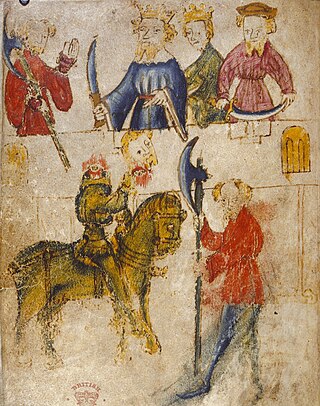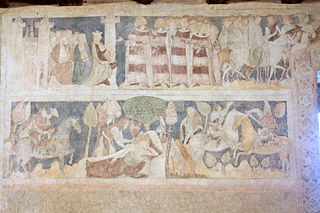
Sir Gawain and the Green Knight is a late 14th-century chivalric romance in Middle English alliterative verse. The author is unknown; the title was given centuries later. It is one of the best-known Arthurian stories, with its plot combining two types of folk motifs: the beheading game and the exchange of winnings. Written in stanzas of alliterative verse, each of which ends in a rhyming bob and wheel, it draws on Welsh, Irish, and English stories, as well as the French chivalric tradition. It is an important example of a chivalric romance, which typically involves a hero who goes on a quest that tests his prowess. It remains popular in modern English renderings from J. R. R. Tolkien, Simon Armitage, and others, as well as through film and stage adaptations.

Guinevere, also often written in Modern English as Guenevere or Guenever, was, according to Arthurian legend, an early-medieval queen of Great Britain and the wife of King Arthur. First mentioned in literature in the early 12th century, nearly 700 years after the purported times of Arthur, Guinevere has since been portrayed as everything from a fatally flawed, villainous, and opportunistic traitor to a noble and virtuous lady. The variably told motif of abduction of Guinevere, or of her being rescued from some other peril, features recurrently and prominently in many versions of the legend.

Gawain, also known in many other forms and spellings, is a character in Arthurian legend, in which he is King Arthur's nephew and one of the premier Knights of the Round Table. The prototype of Gawain is mentioned under the name Gwalchmei in the earliest Welsh sources. He has subsequently appeared in many Arthurian tales in Welsh, Latin, French, English, Scottish, Dutch, German, Spanish, and Italian, notably as the protagonist of the Middle English poem Sir Gawain and the Green Knight. Other works featuring Gawain as their central character include De Ortu Waluuanii, Diu Crône, Ywain and Gawain, Golagros and Gawane, Sir Gawain and the Carle of Carlisle, L'âtre périlleux, La Mule sans frein, La Vengeance Raguidel, Le Chevalier à l'épée, Le Livre d'Artus, The Awntyrs off Arthure, The Greene Knight, and The Weddynge of Syr Gawen and Dame Ragnell.

Lancelot du Lac, alternatively written as Launcelot and other variants, is a popular character in Arthurian legend's chivalric romance tradition. He is typically depicted as King Arthur's close companion and one of the greatest Knights of the Round Table, as well as a secret lover of Arthur's wife, Guinevere.

Mordred or Modred is a major figure in the legend of King Arthur. The earliest known mention of a possibly historical Medraut is in the Welsh chronicle Annales Cambriae, wherein he and Arthur are ambiguously associated with the Battle of Camlann in a brief entry for the year 537. Medraut's figure seemed to have been regarded positively in the early Welsh tradition and may have been related to that of Arthur's son. As Modredus, Mordred was depicted as Arthur's traitorous nephew and a legitimate son of King Lot in the pseudo-historical work Historia Regum Britanniae, which then served as the basis for the subsequent evolution of the legend from the 12th century. Later variants most often characterised Mordred as Arthur's villainous bastard son, born of an incestuous relationship with his half-sister, the queen of Lothian or Orkney named either Anna, Orcades, or Morgause. The accounts presented in the Historia and most other versions include Mordred's death at Camlann, typically in a final duel, during which he manages to mortally wound his own slayer, Arthur. Mordred is usually a brother or half-brother to Gawain; however, his other family relations, as well as his relationships with Arthur's wife Guinevere, vary greatly.

The Matter of Britain is the body of medieval literature and legendary material associated with Great Britain and Brittany and the legendary kings and heroes associated with it, particularly King Arthur. The 12th-century writer Geoffrey of Monmouth's Historia Regum Britanniae is a central component of the Matter of Britain.

The Knights of the Round Table are the legendary knights of the fellowship of King Arthur that first appeared in the Matter of Britain literature in the mid-12th century. The Knights are a chivalric order dedicated to ensuring the peace of Arthur's kingdom following an early warring period, entrusted in later years to undergo a mystical quest for the Holy Grail. The Round Table at which they meet is a symbol of the equality of its members, who range from sovereign royals to minor nobles.

Le Morte d'Arthur is a 15th-century Middle English prose reworking by Sir Thomas Malory of tales about the legendary King Arthur, Guinevere, Lancelot, Merlin and the Knights of the Round Table, along with their respective folklore. In order to tell a "complete" story of Arthur from his conception to his death, Malory compiled, rearranged, interpreted and modified material from various French and English sources. Today, this is one of the best-known works of Arthurian literature. Many authors since the 19th-century revival of the legend have used Malory as their principal source.

The "Gawain Poet", or less commonly the "Pearl Poet", is the name given to the author of Sir Gawain and the Green Knight, an alliterative poem written in 14th-century Middle English. Its author appears also to have written the poems Pearl, Patience, and Cleanness; some scholars suggest the author may also have composed Saint Erkenwald. Save for the last, all these works are known from a single surviving manuscript, the British Library holding 'Cotton MS' Nero A.x. This body of work includes some of the most highly-regarded poetry written in Middle English.
Cleanness is a Middle English alliterative poem written in the late 14th century. Its unknown author, designated the Pearl poet or Gawain poet, also appears, on the basis of dialect and stylistic evidence, to be the author of Sir Gawain and the Green Knight, Pearl, and Patience, and may have also composed St. Erkenwald.

The Green Knight is a heroic character of the Matter of Britain, originating in the 14th-century poem Sir Gawain and the Green Knight and the related medieval work The Greene Knight. His true name is revealed to be Bertilak de Hautdesert in Sir Gawain, while The Greene Knight names him "Bredbeddle". The Green Knight later features as one of Arthur's greatest champions in the fragmentary ballad King Arthur and King Cornwall, again with the name "Bredbeddle".

The Lancelot-Grail Cycle, also known as the Vulgate Cycle or the Pseudo-Map Cycle, is an early 13th-century French Arthurian literary cycle consisting of interconnected prose episodes of chivalric romance originally written in Old French. The work of unknown authorship, presenting itself as a chronicle of actual events, retells the legend of King Arthur by focusing on the love affair between Lancelot and Guinevere, the religious quest for the Holy Grail, and the life of Merlin. The highly influential cycle expands on Robert de Boron's "Little Grail Cycle" and the works of Chrétien de Troyes, previously unrelated to each other, by supplementing them with additional details and side stories, as well as lengthy continuations, while tying the entire narrative together into a coherent single tale.
The Alliterative Morte Arthure is a 4346-line Middle English alliterative poem, retelling the latter part of the legend of King Arthur. Dating from about 1400, it is preserved in a single copy in the 15th-century Lincoln Thornton Manuscript, now in Lincoln Cathedral Library.

The Wedding of Sir Gawain and Dame Ragnelle is a 15th-century English poem, one of several versions of the "loathly lady" story popular during the Middle Ages. An earlier version of the story appears as "The Wyfe of Bayths Tale" in Geoffrey Chaucer's The Canterbury Tales, and the later ballad "The Marriage of Sir Gawain" is essentially a retelling, though its relationship to the medieval poem is uncertain. The author's name is not known, but similarities to Le Morte d'Arthur have led to the suggestion that the poem may have been written by Sir Thomas Malory.
King Arthur and King Cornwall is an English ballad surviving in fragmentary form in the 17th-century Percy Folio manuscript. An Arthurian story, it was collected by Francis James Child as Child Ballad 30. Unlike other Child Ballads, but like the Arthurian "The Boy and the Mantle" and "The Marriage of Sir Gawain", it is not a folk ballad but a professional minstrel's song. It is notable for containing the Green Knight, a character known from the medieval poems The Greene Knight and the more famous Sir Gawain and the Green Knight; he appears as "Bredbeddle", the character's name in The Greene Knight.
Gawain and the Green Knight is a 1973 British film directed by Stephen Weeks, and starring Murray Head as Gawain and Nigel Green in his final theatrical film as the Green Knight. The story is based on the medieval English tale Sir Gawain and the Green Knight and also Yvain, the Knight of the Lion by Chrétien de Troyes and the tale of Sir Gareth in Thomas Malory's Le Morte d'Arthur.
The Awntyrs off Arthure at the Terne Wathelyne is an Arthurian romance of 702 lines written in Middle English alliterative verse. Despite its title, it centres on the deeds of Sir Gawain. The poem, thought to have been composed in Cumberland in the late 14th or early 15th century, survives in four different manuscripts from widely separated areas of England.
Sir Gawain and the Carle of Carlisle is a Middle English tail-rhyme romance of 660 lines, composed in about 1400. A similar story is told in a 17th-century minstrel piece found in the Percy Folio and known as The Carle of Carlisle. These are two of a number of early English poems that feature the Arthurian hero Sir Gawain, the nephew of King Arthur, in his English role as a knight of the Round Table renowned for his valour and, particularly, for his courtesy.
The Knightly Tale of Gologras and Gawain is a Middle Scots Arthurian romance written in alliterative verse of 1362 lines, known solely from a printed edition of 1508 in the possession of the National Library of Scotland. No manuscript copy of this lively and exciting tale has survived.

The beheading game is a literary trope found in Irish mythology and medieval chivalric romance. The trope consists of a stranger who arrives at a royal court and challenges a hero to an exchange of blows: the hero may decapitate the stranger, but the stranger may then inflict the same wound upon the hero. The supernatural nature of the stranger, which makes this possible, is only revealed when he retrieves his severed head. When the hero submits himself to the return blow, he is rewarded for his valour and is left with only a minor wound. The hero is seen as coming of age by undergoing the exchange of blows, and his symbolic death and rebirth is represented by the feigned return blow.












